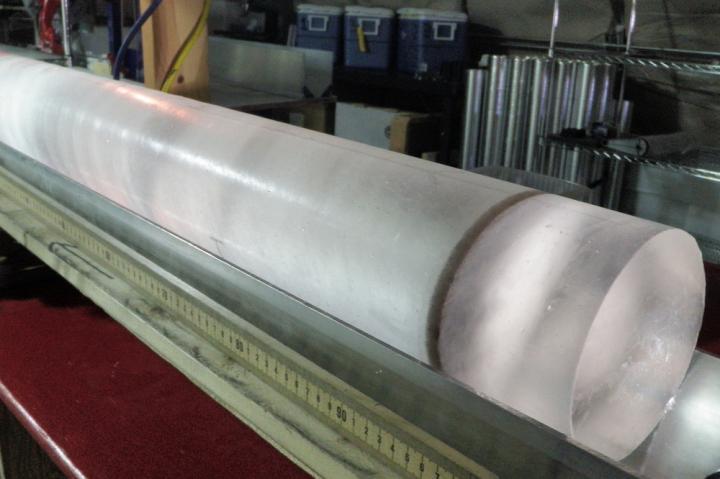

This is a section of the West Antarctic Ice Sheet ice core sample with a dark ash layer.
Image courtesy Heidi Roop
Completed in 2011, the core is packed with information, but it's also packed with noise and error, making the climate story hard to read. Figuring out whether blips in the data are evidence of humans spewing carbon into the atmosphere, odd North Atlantic weather events, or equipment malfunctions often challenges the scientists trying to read the ice cylinder's story.
Drawing from information theory, a research team led by Santa Fe Institute Omidyar Fellow Joshua Garland has proposed new, more sophisticated techniques that promise to make ongoing interpretation of the WAIS core easier and extract new kinds of data that could change the way we think about Earth's climate.
“There is information in these records that we didn't know existed until now, and it has opened doors where we didn't even know there was a door before,” says James W.C. White, director of the Institute of Arctic and Alpine Research and a collaborator on the project.
In the first application of the new technique, Garland, White, and team focus on stable water isotopes present in the ice, the mix of which is a good proxy for nearby sea-surface temperatures at the time ice formed and, therefore, a good way to track climate change over thousands of years. Just plot the isotope mix over time, and you can see how temperatures changed.
What's harder to see, however, is whether those changes result from natural processes or external influences–say, Industrial Revolution activities. That's where information theory and something called permutation entropy come in.
In information theory, entropy is a measure of the unpredictability of information content. Permutation entropy essentially is a way to quantify the predictability of a future event.
Imagine an isolated climate system, void of game changers like supervolcanos or humans. Everything you'd need to predict the future climate would be contained in the Earth's climate history. When game changers arrive, they inject new information that couldn't have been predicted from the climate's past patterns–and that should manifest as an increase in permutation entropy (i.e., more unpredictability).
In fact, there are early signs in the WAIS record of an entropy increase roughly 10,000 years ago, at the beginning of the Holocene, suggesting human impacts on our climate began well before the Industrial Revolution.
Confirmation of that finding is pending. Meanwhile, Garland and team have already made two other surprising discoveries using their technique. The first concerns Dansgaard-Oeschger events, during which Greenland rapidly warms during glacial periods, triggering ripple effects throughout the world.
Geoscientists hypothesize that these events begin with some kind of external shock. But when Garland and team looked at another core, the North Greenland Ice Core, there didn't appear to be an increase in permutation entropy–in other words, no external shock, suggesting the events are likely part of the climate's standard operating procedure. This initial result calls for more study.
In another surprise, Garland and team discovered an anomaly in the WAIS ice-core data that had eluded others–an anomaly they eventually traced to the use of an older instrument to analyze one section of the ice core. Using the permutation entropy technique, WAIS researchers are now looking for similar anomalies deeper in the ice core.
Their paper, “A First Step Toward Quantifying the Climate's Information Production Over the Last 68,000 Years,” appeared last week in Advances in Intelligent Data Analysis XV, the proceedings of the 15th International Symposium on Intelligent Data Analysis, Stockholm, Sweden, October 13-15, 2016.
Media Contact
John German
jdg@santafe.edu
505-946-2798
@sfi_news
http://www.santafe.edu












